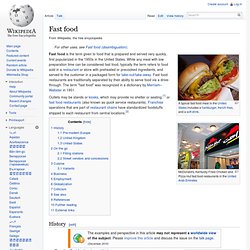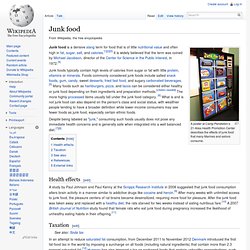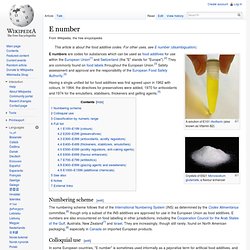

Fast food. Fast food is the term given to food that is prepared and served very quickly, first popularized in the 1950s in the United States.

While any meal with low preparation time can be considered fast food, typically the term refers to food sold in a restaurant or store with preheated or precooked ingredients, and served to the customer in a packaged form for take-out/take-away. Fast food restaurants are traditionally separated by their ability to serve food via a drive-through. The term "fast food" was recognized in a dictionary by Merriam–Webster in 1951. Outlets may be stands or kiosks, which may provide no shelter or seating,[1] or fast food restaurants (also known as quick service restaurants). Franchise operations that are part of restaurant chains have standardized foodstuffs shipped to each restaurant from central locations.[2] History[edit] Pulling wheat dough into thin strands to form lamian The concept of ready-cooked food for sale is closely connected with urban development. Junk food. A poster at Camp Pendleton’s 21-Area Health Promotion Center describes the effects of junk food that many Marines and sailors consume.

Junk food is a derisive slang term for food that is of little nutritional value and often high in fat, sugar, salt, and calories.[1][2][3] It is widely believed that the term was coined by Michael Jacobson, director of the Center for Science in the Public Interest, in 1972.[4] Despite being labeled as "junk," consuming such foods usually does not pose any immediate health concerns and is generally safe when integrated into a well balanced diet.[7][8] Health effects[edit] A study by Paul Johnson and Paul Kenny at the Scripps Research Institute in 2008 suggested that junk food consumption alters brain activity in a manner similar to addictive drugs like cocaine and heroin.[9] After many weeks with unlimited access to junk food, the pleasure centers of rat brains became desensitized, requiring more food for pleasure.
E number. A solution of E101 riboflavin (also known as Vitamin B2) E numbers are codes for substances which can be used as food additives for use within the European Union[1] and Switzerland (the "E" stands for "Europe").[2] They are commonly found on food labels throughout the European Union.[3] Safety assessment and approval are the responsibility of the European Food Safety Authority.[4] Having a single unified list for food additives was first agreed upon in 1962 with colours.

In 1964, the directives for preservatives were added, 1970 for antioxidants and 1974 for the emulsifiers, stabilisers, thickeners and gelling agents.[5] Numbering scheme[edit] The numbering scheme follows that of the International Numbering System (INS) as determined by the Codex Alimentarius committee,[6] though only a subset of the INS additives are approved for use in the European Union as food additives. Colloquial use[edit] Classification by numeric range[edit] Full list[edit] E100–E199 (colours)[edit] Food Additives. List of food additives.